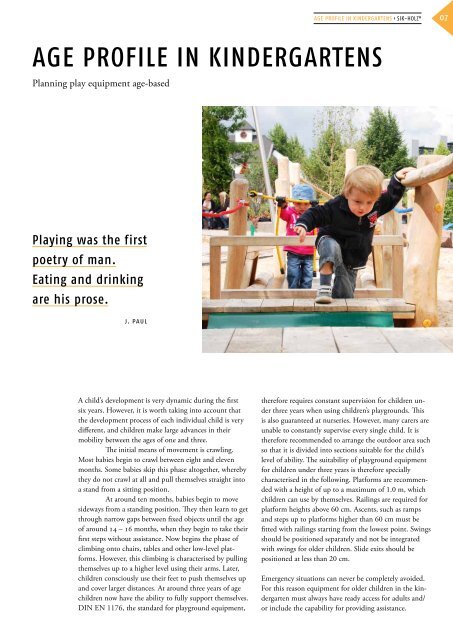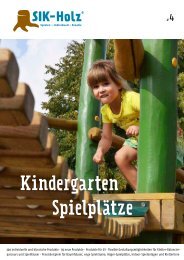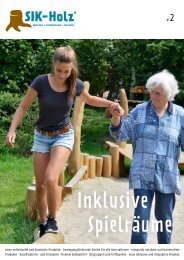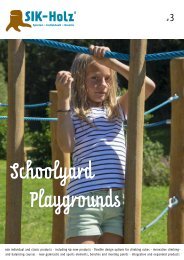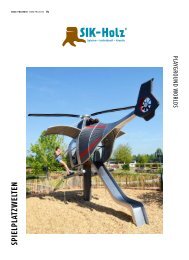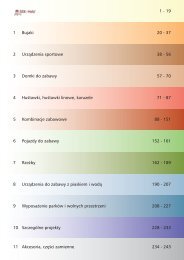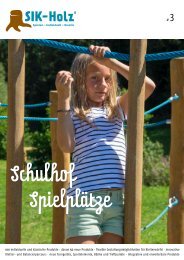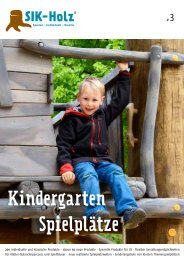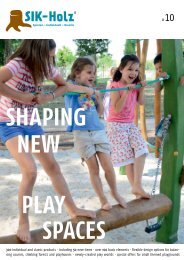sik_kita2015_en
You also want an ePaper? Increase the reach of your titles
YUMPU automatically turns print PDFs into web optimized ePapers that Google loves.
age profile in kindergart<strong>en</strong>s ‹ SIK-Holz®<br />
07<br />
age profile in kindergart<strong>en</strong>s<br />
Planning play equipm<strong>en</strong>t age-based<br />
Playing was the first<br />
poetry of man.<br />
Eating and drinking<br />
are his prose.<br />
j. paul<br />
A child’s developm<strong>en</strong>t is very dynamic during the first<br />
six years. However, it is worth taking into account that<br />
the developm<strong>en</strong>t process of each individual child is very<br />
differ<strong>en</strong>t, and childr<strong>en</strong> make large advances in their<br />
mobility betwe<strong>en</strong> the ages of one and three.<br />
The initial means of movem<strong>en</strong>t is crawling.<br />
Most babies begin to crawl betwe<strong>en</strong> eight and elev<strong>en</strong><br />
months. Some babies skip this phase altogether, whereby<br />
they do not crawl at all and pull themselves straight into<br />
a stand from a sitting position.<br />
At around t<strong>en</strong> months, babies begin to move<br />
sideways from a standing position. They th<strong>en</strong> learn to get<br />
through narrow gaps betwe<strong>en</strong> fixed objects until the age<br />
of around 14 – 16 months, wh<strong>en</strong> they begin to take their<br />
first steps without assistance. Now begins the phase of<br />
climbing onto chairs, tables and other low-level platforms.<br />
However, this climbing is characterised by pulling<br />
themselves up to a higher level using their arms. Later,<br />
childr<strong>en</strong> consciously use their feet to push themselves up<br />
and cover larger distances. At around three years of age<br />
childr<strong>en</strong> now have the ability to fully support themselves.<br />
DIN EN 1176, the standard for playground equipm<strong>en</strong>t,<br />
therefore requires constant supervision for childr<strong>en</strong> under<br />
three years wh<strong>en</strong> using childr<strong>en</strong>’s playgrounds. This<br />
is also guaranteed at nurseries. However, many carers are<br />
unable to constantly supervise every single child. It is<br />
therefore recomm<strong>en</strong>ded to arrange the outdoor area such<br />
so that it is divided into sections suitable for the child’s<br />
level of ability. The suitability of playground equipm<strong>en</strong>t<br />
for childr<strong>en</strong> under three years is therefore specially<br />
characterised in the following. Platforms are recomm<strong>en</strong>ded<br />
with a height of up to a maximum of 1.0 m, which<br />
childr<strong>en</strong> can use by themselves. Railings are required for<br />
platform heights above 60 cm. Asc<strong>en</strong>ts, such as ramps<br />
and steps up to platforms higher than 60 cm must be<br />
fitted with railings starting from the lowest point. Swings<br />
should be positioned separately and not be integrated<br />
with swings for older childr<strong>en</strong>. Slide exits should be<br />
positioned at less than 20 cm.<br />
Emerg<strong>en</strong>cy situations can never be completely avoided.<br />
For this reason equipm<strong>en</strong>t for older childr<strong>en</strong> in the kindergart<strong>en</strong><br />
must always have ready access for adults and/<br />
or include the capability for providing assistance.


